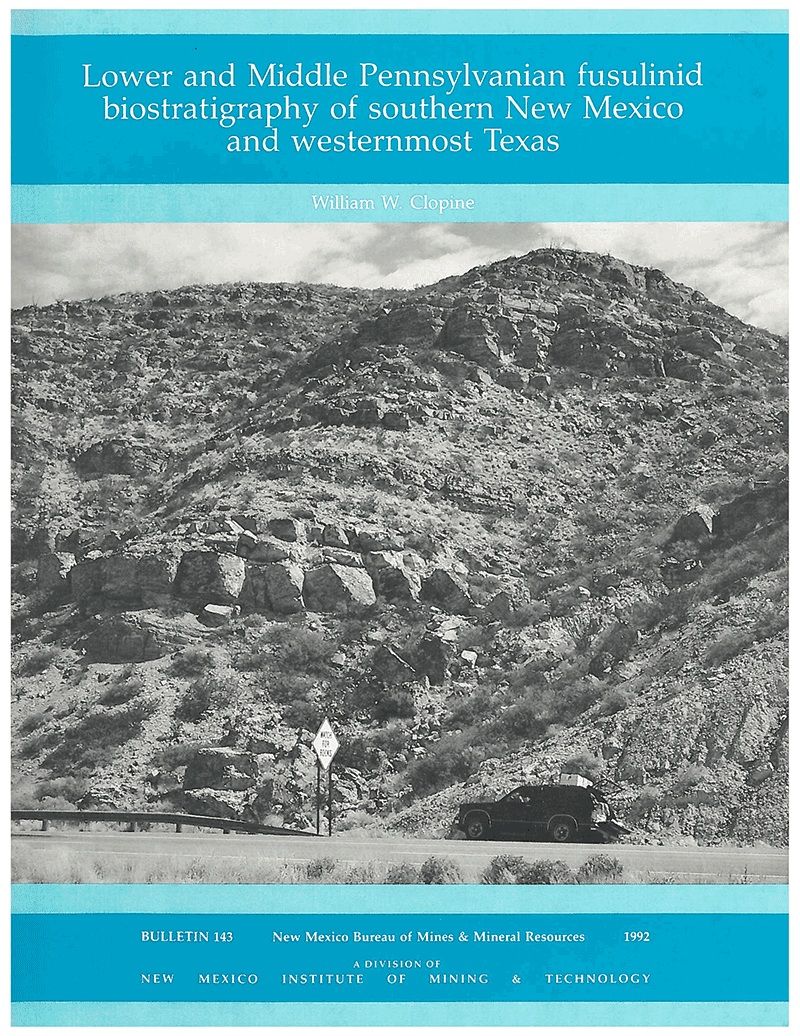
Bulletin 143—Lower and middle Pennsylvanian fusulinid biostratigraphy of southern New Mexico and westernmost Texas
By W. W. Clopine, 1992, 67 pp., 8 figs., 11 plates, 1 appendix.

This paper summarizes biostratigraphic and lithostratigraphic analyses of Lower and Middle Pennsylvanian strata in southern NM and westernmost TX. Fusulinid foraminifera offer the best means of subdivision and biostratigraphic correlation within this interval. Nineteen species in seven genera are documented, one new species is described, and eight biozones are correlated across the study area. Morrowan, Atokan, and early Desmoinesian sediments in the study area represent carbonate-shelf deposits. Shallow subtidal facies are dominant, but limited intertidal and supratidal deposits also occur. Fusulinid foraminifera occur in most carbonate lithologies, but are most abundant and best preserved in shallow subtidal biomicrite-wackestone, the dominant carbonate lithology encountered. Morrowan strata do not extend northward beyond the center of the Robledo Shelf. Earliest Morrowan deposits are restricted to the center of the Orogrande Basin. Morrowan strata thin rapidly to the northwest due to basal onlap above the pre-Pennsylvanian unconformity. Atokan and early Desmoinesian sediments (upper range of study) extend across the Robledo Shelf. The significant thickness variations in these strata across the study area reflect the lower subsidence rate of the Robledo Shelf relative to the Orogrande and San Mateo Basins during Atokan and early Desmoinesian time.
Regional correlations indicate that the lower 0.95 m of the "Derryan Series" type section overlaps the Morrowan Series. However, fusulinid faunas from the remainder of the Derryan type section correlate closely with Atokan faunas from the mid-continent. The upper boundary of the Derryan type section falls just below the first occurrence of Beedeina and corresponds with most authors' concept of the Atokan/Desmoinesian Series boundary.
The Atokan Series, as used in the midcontinent, and the Derryan Series, as defined in south-central NM, include approximately the same stratigraphic interval. Recent workers, however, have abandoned the term Derryan in favor of Atokan. The Atokan Series remains a controversial chronostratigraphic subdivision due in part to its lack of an adequate type section. This paper provides biostratigraphic and lithostratigrpahic analyses of Lower and Middle Pennsylvanian strata in southern NM and westernmost TX, which form a highly fossiliferous sequence of dominantly carbonate rocks. This sequence represents essentially continuous Morrowan through Desmoinesian deposition. These analyses were undertaken in order to better establish the relationships between Pennsylvanian chronostratigraphic units that are in current use but are not adequately defined.
The study area is located in south-central NM and westernmost TX. Four sections have been measured within the study area along a roughly linear northwest-southeast trend stretching approximately 160 km. Pennsylvanian strata crop out along this trend in a series of discontinuous fault-block mountains.
$8.00
Buy
Now
Also available as a free download.
Download
| File Name | Size | Last Modified |
|---|---|---|
| B143.pdf | 8.92 MB | 01/15/2021 01:24:57 PM |



